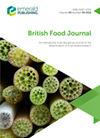质地是新口味吗?感官食物描述符对餐厅菜单访问意向的影响
IF 3.4
3区 经济学
Q1 AGRICULTURAL ECONOMICS & POLICY
引用次数: 1
摘要
目的本研究探讨餐厅菜单上的感官食物描述对餐厅就餐意向及正面口碑传播的影响。设计/方法/方法借鉴信号理论和同化对比理论,两个在线实验和一个实地实验验证了以下假设:食品描述符在消费前后提示食品质量推断,并且在这两个阶段,食品质量推断提示有利的行为意向。感官食品描述通过质量推断对行为意图产生积极影响,尽管并非食品质量的所有方面都能调节这种影响。研究局限性/启示并非所有四个因素(美味、视觉吸引力、多样性和营养)都能在相同程度上促进行为意图。信号理论解释了食品质量推断对消费前行为意图的积极影响,而同化对比理论解释了食品质量推断对消费后再次访问和口碑传播的积极影响。实际意义管理者应该单独使用口腔体感描述符,或者结合味道描述符来提示质量推断和行为意图。原创性/价值研究结果挑战了普遍的假设,即与仅刺激一种感官的食品描述相比,涉及多种感官的食品描述在食品质量推断方面具有更好的效果。相反,食物描述符指的是菜肴的质地、粘度或口感(即口腔体感描述符),对食物质量的推断有影响,而添加风味属性则没有有利的影响。本文章由计算机程序翻译,如有差异,请以英文原文为准。
Is texture the new taste? The effect of sensory food descriptors on restaurant menus on visit intentions
PurposeThis study investigates the impact of sensory food descriptors on restaurant menus on the intention to visit a restaurant and to spread positive word-of-mouth.Design/methodology/approachDrawing on the signalling theory and the assimilation-contrast theory, two online experiments and one field experiment test the assumption that food descriptors prompt food-quality inferences before and after consumption, and that in both stages, food-quality inferences prompt favourable behavioural intentions.FindingsSensory food descriptors impact positively on behavioural intentions through quality inferences, although not all aspects of food quality mediate this effect.Research limitations/implicationsNot all four factors (deliciousness, visual attractiveness, variety and nutritiousness) prompt behavioural intentions to the same extent. While the signalling theory explains the positive impact of food-quality inferences on behavioural intentions before consumption, the assimilation-contrast theory explains the positive effect food-quality inferences have on the intention to revisit and word of mouth after consumption.Practical implicationsManagers should use either oral somatosensory descriptors alone, or in combination with flavour descriptors to prompt quality inferences and behavioural intentions.Originality/valueThe findings challenge the prevailing assumption that food descriptors addressing multiple senses have a superior effect on food-quality inferences compared to food descriptors stimulating only one sense. Instead, food descriptors referring to the texture, viscosity or mouthfeel of a dish, (i.e. oral somatosensory descriptors), impact on food-quality inferences, while adding flavour attributes did not have favourable effects.
求助全文
通过发布文献求助,成功后即可免费获取论文全文。
去求助
来源期刊

British Food Journal
工程技术-食品科技
CiteScore
6.90
自引率
15.20%
发文量
219
审稿时长
18-36 weeks
期刊介绍:
After 115 years, the British Food Journal (BFJ) continues to be highly respected worldwide for its broad and unique interdisciplinary coverage of the latest food-related double blind peer-reviewed research. It links all sectors of this dynamic industry, keeping abreast of emerging trends, topical and controversial issues and informing and stimulating debate. - See more at: http://emeraldgrouppublishing.com/products/journals/journals.htm?id=bfj#sthash.O3wH4pEh.dpuf
 求助内容:
求助内容: 应助结果提醒方式:
应助结果提醒方式:


